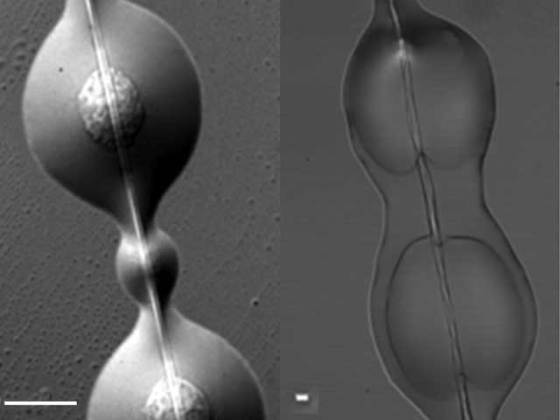Spider silk glue biomimicry could lead to better performing adhesives
 A team of researchers from the University of Akron (UA) has observed two species of spiders in order to develop stimuli-resistant and stimuli-sensitive materials. The research shows that the sticky glue that coats the silk threads orb-weaving spiders spin has a different structure, property makeup and response to humidity than glues produced by their evolutionary descendants, cobweb-weaving spiders.
A team of researchers from the University of Akron (UA) has observed two species of spiders in order to develop stimuli-resistant and stimuli-sensitive materials. The research shows that the sticky glue that coats the silk threads orb-weaving spiders spin has a different structure, property makeup and response to humidity than glues produced by their evolutionary descendants, cobweb-weaving spiders.
The cobweb spider’s gumfoot glue acts as a viscoelastic liquid that is resistant to changes in humidity, and maintaining constant elasticity and adhesion. On the other hand, orb weavers, produce glue that acts like a viscoelastic solid. This glue is highly humidity-sensitive, expands in magnitude and demonstrates a monotonous increase in elasticity under increased humidity. The glue also displays a decrease in surface adhesion that results in optimal adhesion at intermediate humidity.
After performing tests such as single drop pull-off and load-relaxation measurements, thread pull-off measurements, stress-strain and drop volume measurements, the UA researchers decided to simplify the process and create a polymer model with appropriate properties in order to understand the underlying mechanism of the orb web spider’s silk adhesive.
The polymer model was made of high molecular weight polyethylene oxide (PEO) dissolved in water solutions of different concentrations. For the same pull-off rates, the energy of adhesion increased with higher water concentration, reached a maximum, and then reduced with further increase in humidity.
At lower concentrations of water, the viscosity and elasticity are very high, but the spreading rates are very slow and the area of contact is smaller. At high concentrations of water, the spreading rates are fast, but the viscous and elastic forces are lower. The interplay between these two effects leads to an optimum stickiness at intermediate humidity.
Behaviors of natural biomaterials, such as the spider glue responses to humidity in this research, provide templates for developing smart materials and devices that change dimension, property makeup and function in response to external stimuli. Further investigation of such processes could result with new synthetic adhesives that perform well in presence of water or humidity.
For more information, you can read the article published in the Scientific Reports named: “Changes in the Adhesion Properties of Spider Aggregate Glue During the Evolution of Cobwebs“.










Excellent case of biomimicry. Yes. Spider silk glue is indeed strong.
Dr.A.Jagadeesh Nellore(AP),India
E-mail: anumakonda.jagadeesh@gmail.com
Where can I buy the glue?
i don’t think it has been commercialized yet.